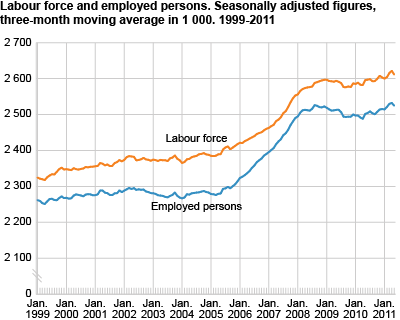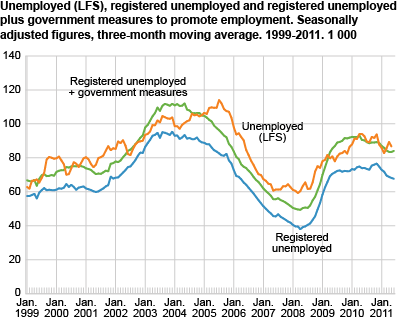Content
Published:
This is an archived release.
Lower participation rate for young people
The labour force participation rate among young people aged 15-24 decreased by three percentage points from the 2nd quarter of 2010 to the 2nd quarter of 2011. More people stayed in education.
|
Seasonally - adjusted figures : Stable unemployment and employment The unemployment rate was 3.3 per cent of the labour force in the 2nd quarter of 2011. The increase from 3.2 per cent in the 1st quarter is within the margin of error. Adjustments for seasonal variations allow for the analysis of current developments in the labour market, and serve as an alternative to comparisons with the corresponding quarter in the previous year. Seasonally-adjusted figures are presented in a separate article . |
In the 2nd quarter of 2011 the labour force participation rate (the sum of employed and unemployed) in Norway was 71.7 per cent. This is a decrease from 72.5 per cent in the 2nd quarter of 2010. This should be seen in conjunction with the heavy population growth especially among people aged 20-24 and 65, which are age groups with low participation rate.
|
The labour force is the sum of employed and unemployed between 15-74 years of age. From the 2nd quarter of 2010 to the 2nd quarter of 2011 the LFS shows that the employment rose by 22 000 persons and the unemployment fell by about 8 000 persons. This gives an increase in the labour force on the lower edge of 15 000 persons. Due to a population growth of 63 000 persons in the same period, there is nevertheless a decrease in the labour force participation rate. The coherence between the conceptsUnemployed + Employed = Labour force Labour force + Outside the labour force = Population |
More people in education and more retired people
The population aged 15-74 increased by 63 000 persons from the 2nd quarter 2010 to the 2nd quarter 2011, while labour force increased just by 15 000 persons. Among people outside the labour force there was an increase in the number of people in education (18 000) and in the number of retired or disabled people (23 000).
Increase in employment within human health and social work activities
The number of employed within human health and social work activities increased by 13 000 persons between the 2nd quarter of 2010 and the same quarter of 2011. There was at the same time a reduction of the same magnitude in employment within real estate, technical activities etc. In the other industries there were only minor changes in the employment.
There were 13 000 less people on temporary contracts in the 2nd quarter of 2011 compared with the corresponding quarter in 2010. The 189 000 people on temporary contracts amounts to 8 per cent of all the employees aged 15-74 in the 2nd quarter of 2011, down by 0.7 percentage points from last year.
Higher proportion long-term unemployed
The number of unemployed decreased by about 8 000 persons from the 2nd quarter of 2010 to the same quarter in 2011. Most of the decrease was among people with only a short period of unemployment. The long-term unemployment raised from 31 per cent in the 2nd quarter of 2010 to 33 per cent in the same quarter of 2011. Long-term unemployed are people who have been out of work for more than 26 weeks.
More underemployed
The number of underemployed increased by 6 000 persons from the 2nd quarter of 2010 to the corresponding quarter in 2011. Underemployment is employees with a contract on part-time work who have tried to find more work. As a proportion of all part-time employed people the number of underemployed increased from 10.3 to 11.2 per cent.
Together, the groups of underemployed and unemployed wanted work corresponding to 108 000 full-time equivalents in the 2nd quarter of 2011 - down 7 000 from the year before.
Tables:
- Table 1. Population aged 15-74 by labour force status(LFS) and sex 1000
- Table 2. Population aged 15-74 by labour force status (LFS) and sex. Changes from the same period inthe previous year. 1000
- Table 3. Population aged 15-74 by labour force status(LFS) and sex. Per cent
- Table 4. Persons in the labour force and employed persons aged 15-74, by age and sex (LFS). 1000
- Table 5. Persons in the labour force and employed persons aged 15-74, by age and sex (LFS). In per cent of the population
- Table 6. Persons aged 15-74, employed persons by contractual/usual working hours per week1 and unemployedpersons by age and sex (LFS). 1000
- Table 7. Persons in the labour force aged 15-74 by age and sex (LFS). 1000
- Table 8. Persons in the labour force aged 15-74 by age and sex (LFS). As per cent of all in each group
- Table 9. Employed persons aged 15-74 by sex and contractual/usual working hours per week (LFS). 1 000
- Table 10. Population aged 15-74, by main activity1, part-time employment and age (LFS). 1 000
- Table 11. Employed persons aged 15-74 by major industry division (LFS). 1 000
- Table 12. Average number of man-weeks worked2(37,5 hours), by industry division (LFS). 1 000
- Table 13. Employed persons aged 15-74 and average number of man-weeks worked1(a 37.5 hours)by sex and status. 1000. Actual working hours, by sex and status. Hours perweek.
- Table 14. Employed persons aged 15-74 and absence from work1 during the whole reference weekby reason for absence and sex (LFS). 1 000
- Table 15. Employed persons aged 15-74 and absence from work1 during the whole reference weekby reason for absence and sex (LFS). Per Cent
- Table 16. Employees aged 15-74 with temporary jobs, by major industry division (LFS). 1000
- Table 17. Employees aged 15-74 with temporary jobs, by major industry division (LFS).In per cent of all employees
- Table 18. Unemployed persons aged 15-74 by sex and age (LFS). 1000 andper cent
- Table 19. Unemployed persons aged 15-74 by duration of job search (LFS).1 000 and per cent
- Table 20. Unemployed persons aged 15-74, by main activity (LFS). 1 000
- Table 21. Unemployed and underemployed persons aged 15-74, by sex and desired working hours per week.Number of man-weeks (of 37,5 hours) supplied
- Table 22. Employed persons aged 15-74, by sex and region of residence(LFS) 1 000
- Table 23. Employed persons aged 15-74, by sex and region of residence (LFS) as per cent of all inn each group
Contact
-
Arbeidsmarked og lønn
E-mail: arbeidsmarked@ssb.no
-
Erik Herstad Horgen
E-mail: erik.horgen@ssb.no
tel.: (+47) 93 08 68 62
-
Håvard Hungnes Lien
E-mail: havard.lien@ssb.no
tel.: (+47) 40 90 26 06


